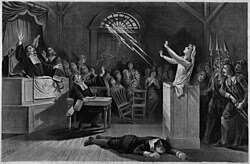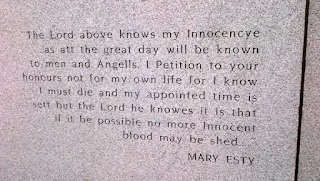Rebecca (Towne) Nurse, the daughter of William and Joanne (Blessing) Towne was baptized on 21 February 1621 in Great Yarmouth, co. Norfolk, England. She was one of eight children and came with her parents to Massachusetts in 1635, settling at Salem, Massachusetts (now Danvers, Massachusetts). She married Francis Nurse around 1644 and had eight children. He was a tray maker by occupation. He was a Constable of Salem, and Rebecca was known as a pious woman in the community.
On 23 Mar 1692, a warrant was issued for the arrest of 71 year old Rebecca Nurse based on accusations of Edward and John Putnam. Upon her arrest, she stated said, "I am innocent as the child unborn, but surely, what sin hath God found out in me unrepented of, that He should lay such an affliction on me in my old age." Another accusation came from Sarah Holton, a neighbor who claimed that Rebecca upset about their pigs trespassing on their property cursed her husband, Benjamin Holton. The night of the quarrel, Benjamin began having convulsions and died several weeks later. Despite this claim, Sarah spoke out against the injustice of the trials.
 |
| Drawing of Rebecca Nurses's trial |
At her trial on 30 June 1692, she was not allowed to have a lawyer and the “afflicted girls” often claimed Rebecca was tormenting them and their spectral evidence was allowed. Many people spoke on her behalf and she was found not guilty. However, due to the public outcry and the torment of the young girls, the jury asked for a second chance of deliberation. She was asked to explain a remark she made about Deliverance Hobbs “being of her company.” Rebecca who was hard of hearing thought they were referring to Deliverance being another accused witch. She was found guilty and sentenced to death by hanging on 19 July 1692.
Sarah (Towne) Cloyce was born 7 January 1637 in Salem, Massachusetts. She married John Bridges and had several children before his death. She remarried to Peter Cloyce/Cloyse, a widower and had three more children.
On 27 March 1692, after Rev. Parris spoke of the evil afflicting his family and congregation. After reading a passage, Sarah Cloyce got up and left the sermon slamming the door behind, which some felt was in solidarity with her sister Rebecca Nurse.
 |
| Darwing of the accused at public Interrogation |
On 11 April 1692, the 50-year-old, Sarah was interrogated and maintained she was innocent. She was jailed without bail and taken to a prison in Boston. Returning later in June to a prison in Ipswich.
It was after the deaths of her sisters that Governor William Phips dissolved the court in October 1692. A new Superior Court was formed in December 1692 and in January 1693, the new court dismissed the charges against. However, Sarah and her husband still had to pay her prison fees. They immediately petitioned to be released from church and moved their membership to Framingham, Massachusetts where they settled.
Mary (Towne) Eastey was baptized on 24 August 1634 in Great Yarmouth, Norfolk, England. After her arrival in Salem, Massachsuetts, she married Isaac Eastey, a farmer and barrell maker in 1655. They had eleven children. Like her sister Rebecca Nurse, Mary was a pious and respected citizen of Salem, and her accusation came as a surprise.
During the examination on 22 April 1692, when Eastey clasped her hands together, Mercy Lewis, one of the afflicted, imitated the gesture and claimed to be unable to release her hands until Mary released her own. Again, when Mary inclined her head, the afflicted girls accused her of trying to break their necks. Mercy claimed that Mary’s spectre had climbed into her bed and laid her hand upon her breasts. In the face of such public hysteria, Mary Eastey defended herself with remarkable eloquence: when she was asked by the magistrates John Hawthorne and Jonathan Corwin how far she had complied with Satan, she replied, "Sir, I never complied with Satan but prayed against him all my days, I have no compliance with Satan, in this ... I will say it, if it is my last time, I am clear of this sin." Hathorne, showing a momentary doubt about her guilt, went so far as to ask the girls if they were quite sure that Mary Eastey was the woman who afflicted them.
 |
| Spectre Evidence at Witchtrials |
Mary Eastey was released from prison on 18 May 1692 after two months. However, on 20 May, Mercy Lewis claimed that Eastey's spectre was afflicting her, a claim which other girls supported. A second warrant was issued that night for Eastey's arrest. She was taken from her bed and returned to the prison; Lewis ceased her fits after Eastey was chained. Eastey was tried and condemned to death on 9 September and hung to death on 22 September 1692.
In the aftermath of the trials with only one sister who survived she spent her time trying to clear her sisters’ names. The Eastey family received 20 pounds compensation for her wrongful death in 1711. In the decades following the trials, survivors and family members (and their supporters) sought to establish the innocence of the individuals who were convicted and to gain compensation. In the following centuries, the descendants of those unjustly accused and condemned sought to honor their memories. Events in Salem and Danvers in 1992 were used to commemorate the trials. In November 2001, years after the celebration of the 300th anniversary of the trials, the Massachusetts legislature passed an act exonerating all who had been convicted and naming each of the innocent. The trials have figured in American culture and been explored in numerous works of art, literature and film.


